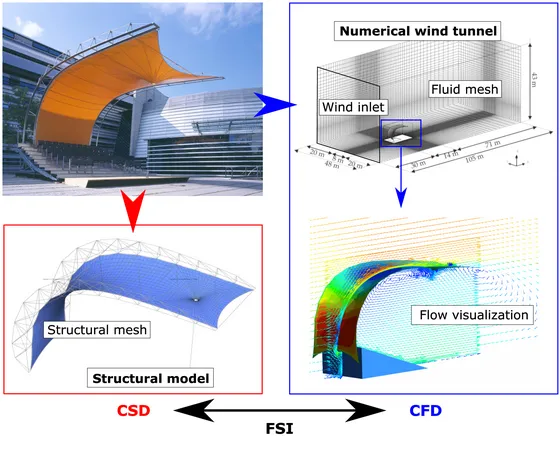Modeling Aspects and Numerical Simulations in Wind Engineering
The study of complex wind effects especially needs to be assessed as constructions are pushed to the limit and are thus typically out of the range of engineering experience and standards. Current trends in the civil engineering industry comprise of high and slender buildings, long and flexible bridges as well as a revival of light-weight structures in general. This tendency to build lighter and more slender is also supported by the availability of new, high-strength materials. The resulting constructions are prone to complex wind response and an in-depth study has to be carried out for assessing wind-induced phenomena.
State of the art computational methods for simulating and quantifying the effects of wind represent a main field of research at the Chair of Structural Analysis. It is in response to the necessity of relying more and more on numerical methods for solving challenging problems which have gained significant ground in the academic and industrial community over the last decades. This is backed up by the rapidly increasing computing power.
Wind Engineering is a completely interdisciplinary field which involves meteorology, fluid mechanics, structural dynamics, statistics and probability theory, geographic information systems and some other branches. Although aerodynamics is one of the pillars of wind engineering, many of the applications in wind engineering are non-aeronautical. For structural engineers the evaluation of wind loads on constructions is the most important task and the clear goal is to design a safe and economical structure. A good understanding of fluid and structural mechanics is the necessary background for understanding the interaction between wind flow and civil engineering structures.
Computational Wind Engineering (CWE) is primarily defined as the use of Computational Fluid Dynamics (CFD) for wind engineering applications, although it includes other approaches of computer modeling and in the broadest sense also field and wind-tunnel measurements supporting CWE model development and evaluation.
Recent advancements in the available computational power, as well as the research and development of algorithms in this field are opening possibilities, which were unheard of a decade ago. The realistic numerical simulation of structures in the atmospheric boundary layer flow could be set up from the following three key tools of CWE:
- CFD – Computational Fluid Dynamics: uses numerical methods and algorithms to solve and analyze problems that involve fluid flows. In the context of CWE it is responsible for resolving the wind flow and its relevant features;
- CSD – Computational Structural Dynamics: is modeling of linear or even nonlinear phenomena in solid and structural dynamics (large deformations or nonlinear material laws) with numerical methods and algorithms;
- FSI – Fluid-Structure Interaction: is in the context of CWE present as the interaction of typically light-weight or large structures with wind.
Numerical methods are complementary tools to experimental wind or water channel experiments and code-based design, as these still represent the more traditional and established methods. Nonetheless, CWE has broadened its user base and recent developments consolidate its usability alongside the traditional methods thus showing a promising outlook. For some special structures CWE might be the only way of assessing the wind-induced response.
